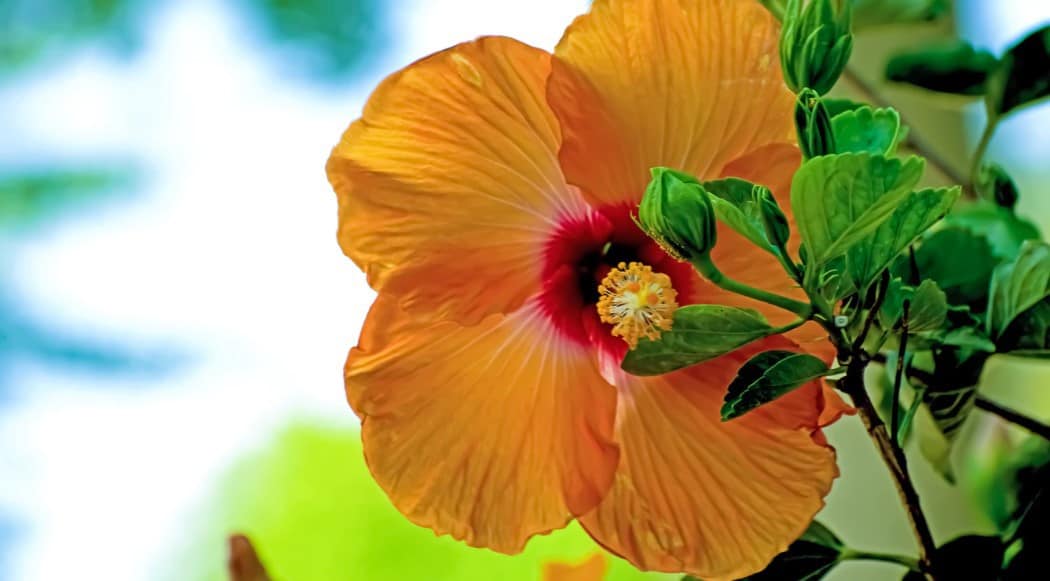Yellowing leaves are a sign that something is wrong with your plant. It could be as a result of several factors or just one single issue. Either way, you should figure out what is wrong with your plant and remedy it before it dies.
While you may panic and think your plant is unsalvageable once the hibiscus leaves turn yellow, reviving it is easier than it seems. Once you figure out the cause of the yellowing leaves, you are good to go.
Causes of Yellowing Hibiscus Leaves
Below are some causes of yellowing hibiscus leaves and solutions you can use to treat yellow leaves on hibiscus;
Overwatering
Hibiscus plants require a lot of water but do not like to be waterlogged. Yellowing leaves are signs that your hibiscus is overwatered, but it can also be a sign of under-watering. Water your hibiscus plants only when the soil is dry.
Poor soil drainage
Use a potting mix that drains water to ensure the roots of your potted hibiscus do not become waterlogged. Also, avoid packing the soil too tightly when repotting your hibiscus to prevent root suffocation.
Temperature
Temperature changes cause hibiscus plants to adapt to stress caused by environmental changes. This can result in hibiscus leaf discoloration. Keep your plants from extremely high temperatures as well as extremely low temperatures.
Insect invasion
Aphids are a significant cause of yellowing leaves when it comes to insect infestation. Other insects to look out for include spider mites. Aphids tend to cluster on the plants’ tips while the spider mites tend to invade the leaves’ underside. You may be able to remove the aphids manually or by spraying them with a stream of water.

Dormancy
When exposed to freezing temperatures, your hibiscus plants may become dormant, which may cause the leave to turn yellow and fall off. This is a common occurrence in colder regions. To remedy this issue, bring your potted hibiscus plant indoors.
Poor Nutrition
Poor soil composition will starve your potted plants of the required nutrients that cause them to turn yellow. To remedy this issue, use fertilizer at least twice annually to ensure the soil is sufficiently nitrified and balanced.
Wrong Fertilizer or Herbicide Application
Using a concentrated amount of fertilizer or herbicides on your hibiscus plants can burn their roots and cause the leaves to turn yellow. Ensure you follow instructions when applying fertilizer or herbicides to your potted plants.
How Often Do You Need to Water Hibiscus?
Hibiscus plants require a lot of water for them to flourish. If you live in an arid area, then you need to water them two times daily on sweltering summer days. And once a day on the other seasons. You can get away with watering them once a day if you plant them in a shaded area. Or if you live in a region with fairly cold weather.
If you cannot water them regularly, plant them in larger pots that can hot more water to ensure they do not get dehydrated quickly. Alternatively, you can use drip irrigation or a water bottle reservoir to keep them hydrated.
Should I remove Yellow Leaves from Hibiscus
It is unnecessary as they will fall off on their own, and new leaves will ultimately sprout in their place. However, to avoid plant infection from molding leaves, you can remove them, especially if the soil used to pot your hibiscus plants tend to retain water.
Are Coffee Grounds Good for Hibiscus?
Yes. This is because hibiscus plants love acidic soil. Coffee grounds act as an acidic fertilizer that is nourishing for hibiscus plants. Compost the coffee grounds in the soil to allow them to break down and nourish the soil instead of placing them around the plant.
Check this too: How to Grow Forget Me Nots in Pots
Coffee grounds release nitrogen into the soil, which helps plants have stronger and healthier roots by eliminating bacteria. It also prevents slug and snail inhabitation. It is also a cat deterrent.
Now that you have figured out what is causing your hibiscus plant leaves to turn yellow, here are some tips for caring your hibiscus plant;
- Remedy the issue that was causing the leaves to turn yellow.
- Prune your plants regularly to prevent wastage of nutrients on dying leaves and branches.
